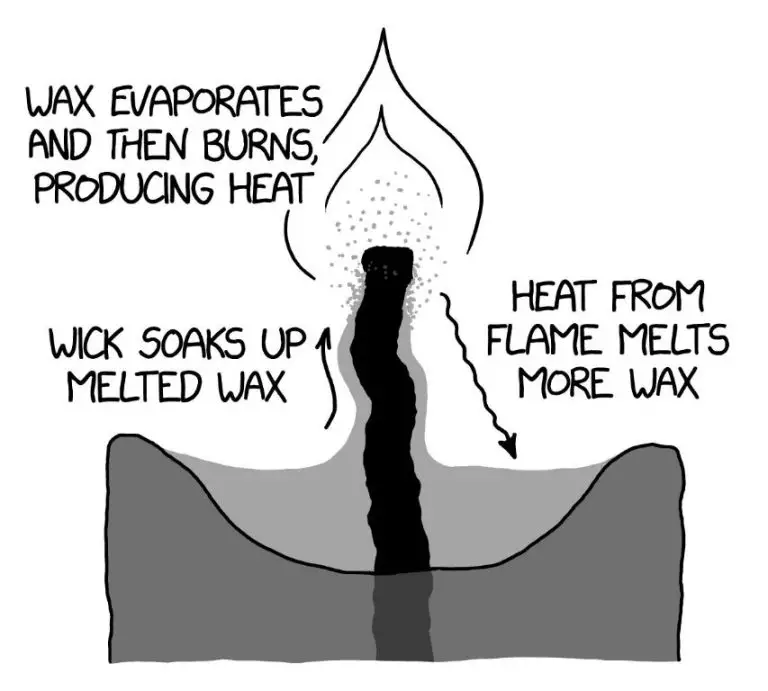What Can I Use Instead Of A Wick Trimmer?
Why Use a Wick Trimmer in the First Place
Wick trimmers are a candle accessory used specifically to trim candle wicks. Keeping the wick trimmed to an optimal length is important for clean, safe, and even burning. As the candle burns down, the wick becomes longer and can start to bend, drown in melted wax, or create excess smoke and soot.
Trimming the wick to 1/4″ before each lighting helps sustain a bright flame. The wick trimmer’s sharp blades allow for a quick, precise cut. This helps the wick stay centered in the melted wax pool. A trimmed wick also curls evenly as it burns, preventing uneven melting or tunneling.
Without trimming, long wicks create smoke, drips down the side of the candle, and floating pieces of carbon. Trimming prevents these issues and improper burning that shortens candle life. The right wick length supports the candle’s original scent throw and burn rate.
Scissors
Scissors are likely the most basic household item that can substitute for a dedicated wick trimmer. Most homes already have a pair of scissors on hand that can be repurposed to trim candle wicks.
Using a standard pair of scissors to trim wicks has some advantages:
- No need to purchase a speciality tool – saves money
- Scissors are readily available in most homes
- Easy to control the height and angle of the cut
There are some potential downsides to be aware of when using scissors for wicks:
- The blade is not angled like a proper wick trimmer, making precision trickier
- Dull blades may crush the wick instead of cutting it
- No catcher to capture trimmed pieces of wick
With care and a steady hand, most household scissors can substitute for a wick trimmer in a pinch. They provide a cost-effective and convenient alternative using tools you likely already own.
Nail Clippers
Nail clippers can be an effective alternative for trimming candle wicks when a dedicated wick trimmer is not available. The main benefits of using nail clippers for this purpose are that they are typically very sturdy and sharp, allowing for precise trimming of wicks.
The thick metal construction and sharp blades of most nail clippers are ideal for cutting through cotton and paper wicks with ease. While the average pair of nail clippers is smaller than a specialized wick trimmer, the cutting edge is still wide enough to trim standard wick widths.
Look for a heavy-duty pair of nail clippers made from quality stainless steel. The stiffness of the lever and sharpness of the blades are key for clean cuts. Avoid cheap, light-weight nail clippers that may not stand up to repeated trimming or could potentially bend or warp the wick, leading to an uneven burn.
With nail clippers you can achieve the right level of wick height for optimal candle performance. Just be careful to make straight cuts and avoid fraying the wick. For best results, trim the wick to around 1⁄4 inch before lighting to prevent excess smoking and promote an even flame.
Craft Knife or Box Cutter
A craft knife or box cutter can be a handy substitute for a wick trimmer. These tools have extremely sharp blades that are designed to cut through thick materials with precision. When using the right technique, the sharp blades can provide clean, straight cuts on wicks.
Look for a craft knife or box cutter that has a fixed or retractable blade. Opt for a longer blade, around 1-2 inches, which will allow you to cut all the way across thicker wicks in one motion. Shorter hobby knives may require you to cut in multiple passes, which can result in uneven cuts. The sharpness of the blade is key for getting clean cuts without fraying the wick.
When cutting the wick, hold the craft knife at a 45 degree angle to the wick and apply firm, even pressure as you cut across. You may need to flatten the wick out a bit to keep it steady. For safety, always cut away from yourself and on a stable, hard surface. Be cautious to not let your fingers get near the sharp blade.
With practice using the right technique, a new box cutter or craft knife blade can slice wicks as neatly as a dedicated wick trimmer. Just be careful when handling these sharp tools and replace the blades as soon as they start to dull.
Wire Cutters
Wire cutters provide a perfectly straight cut, so they work very well to trim thick candle wicks. The sharp blades of wire cutters slice through thicker wicks with ease, unlike scissors which can crush and fray the wicks. Ensure the wire cutters you use are clean and only used for craft purposes, not for cutting metal wire. Open the wire cutters wide enough to fit the width of the wick and get as close to the candle surface as possible for a neat trim.
Unlike scissors, wire cutters won’t leave any jagged edges or frays. The straight, clean cut helps the wick burn evenly when the candle is lit. Wide jaw wire cutters are best as they provide more control and stability when cutting wider wicks. Make sure to carefully snip perpendicular to the wick for the most professional result.
Kitchen Shears
Most kitchens already have a pair of kitchen shears on hand for food preparation tasks. These sturdy scissors have short, sharp blades perfect for snipping herbs, cutting meat off bones, and trimming wicks. Kitchen shears are designed for strength and leverage when cutting, with cushioned handles for comfort.
As a multipurpose tool, kitchen shears provide a convenient option for wick trimming without having to buy specialized equipment. Look in your kitchen drawer for shears with micro-serrated blades to cleanly cut through wick fiber. Make sure to only use clean shears designated for crafting, not for food, to avoid contamination.
The main downside to kitchen shears is potential inaccuracy in getting a straight cut compared to single blade tools. Take care to cut perpendicular to the wick for best results. Work on a cutting board and go slowly. Kitchen shears get the job done for basic wick trimming when no other tool is on hand.
Razor Blade
A razor blade is another handy household item that can substitute for a wick trimmer in a pinch. The sharp, thin edge of a razor blade allows for very precise and detailed trimming of your candle wicks.
To use a razor blade, simply hold the base of the wick gently between two fingers while using the razor edge to slice off any excess length in one smooth motion. Take care not to apply too much pressure, as you only want to trim the wick and not cut into the wax of the candle itself.
Razor blades allow you to trim your wicks to the optimal height every time. Just be cautious when handling the exposed blade and dispose of used blades properly to avoid injury.
Pinking Shears
Pinking shears have blades that are saw-toothed, resulting in a zigzag cut. This leaves the ends of the wick with a versatile wave-like shape that should help with burning and reducing issues like tunneling. Unlike scissor or razor straight cuts, the zigzag profile from pinking shears results in ends with more surface area and grip in the melted wax.
The zigzag cut also seals the wick fibers together for a tight and tapered tip, reducing fraying issues you may get from the straight cut of regular scissors. This helps the wick burn efficiently right from the start without needing to initially heat and shape the end. The blades on pinking shears are also very sharp, allowing for clean cuts all the way through thicker wicks.
While scissors may crush the wick fibers, pinking shears slice through them cleanly. The tight serrated grip of pinking shear blades also makes it easy to hold wicks of any thickness in place while cutting. With practice, you can produce neat and precise wick ends in seconds.
Making Your Own Wick Trimmer
If you want a wick trimmer that is customized to your specific needs, making your own is an option. The main benefit of a homemade wick trimmer is you can design it to fit your candles and wicks perfectly.
To make a basic wick trimmer, you will need:
- A flat, thin piece of metal or plastic, like a paint stir stick or old gift card
- Super glue
- Sandpaper
- A drill with various small drill bits
Cut the flat piece of metal or plastic to your desired length and width for the wick trimmer. Sand and smooth the edges so they are not sharp. Clamp the trimmer piece to your work surface.
Use the drill to make holes in the metal or plastic where you want them. Space the holes evenly apart at the distance you need to fit your wick sizes. Make sure the holes are just slightly larger than your wicks.
You can customize your homemade wick trimmer in many ways. Make multiple rows of holes for different wick sizes. Cut decorative shapes into the edges. Paint or lacquer the surface. Add grip tape or sandpaper to reduce slipping. Include a handle hole at the top for easy holding.
The advantage of a homemade wick trimmer is you can tweak the design over time to create the perfect trimmer for your candlemaking. It takes some trial and error, but the end result will be a useful, customized tool.
Considerations
When choosing an alternative tool to use instead of a wick trimmer, there are a few important factors to consider:
First, you’ll want a tool with a very sharp edge. Dull scissors or knives won’t make clean, precise cuts. Look for options made of high-quality steel that will retain their sharp edge.
Precision is also key – the tool should allow you to trim the wick to an exact desired height. Thick, clunky tools like kitchen shears likely won’t have the finesse needed for detail work.
Safety is another concern. Be cautious handling razor blades or box cutters without proper finger guards. Opt for tools like nail clippers or sewing scissors that are designed for use in close proximity to hands and fingers.
Test any tool on scrap wick material first and go slowly to ensure you can achieve the perfect trimmed wick every time. With the right alternative tool and proper care, you can ditch the specialized wick trimmer.




